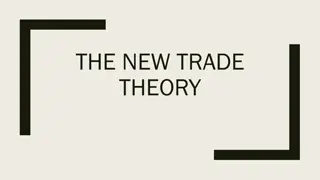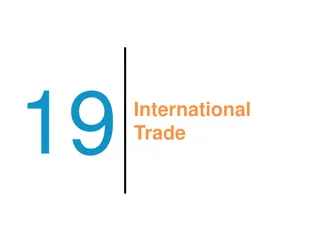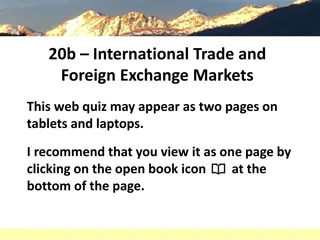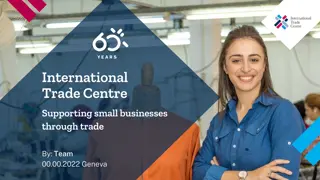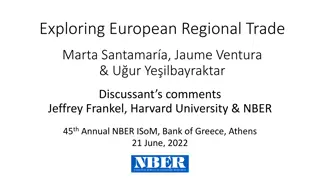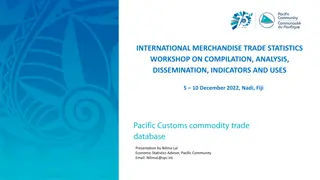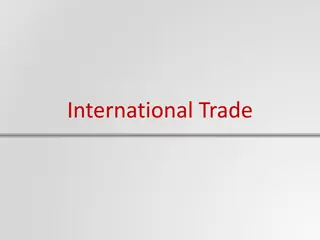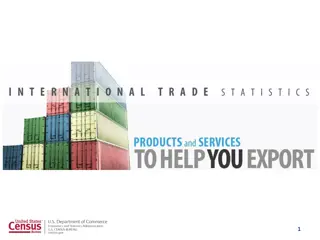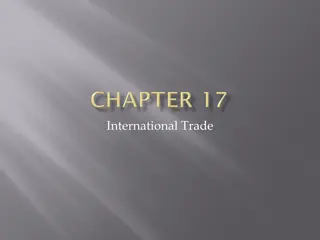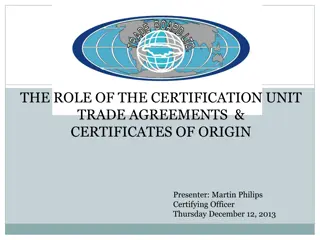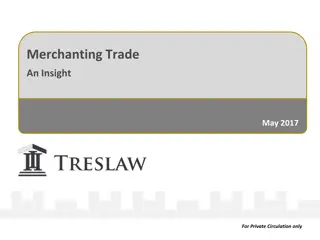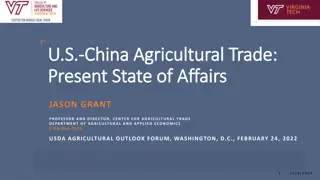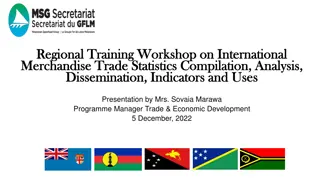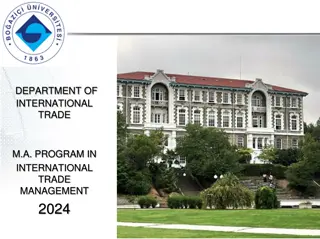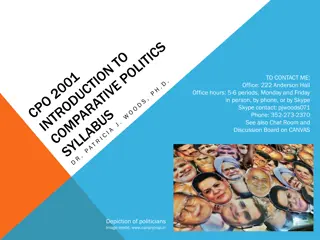State-Centered Approach to International Trade Politics
State-centered approach in international trade politics highlights how national policymakers intervene in the economy to pursue objectives independent of domestic interest groups. This intervention can impact social welfare and is guided by specific government initiatives to foster national industries. The approach contrasts with society-centered views, emphasizing the influence of protectionism on social welfare and the role of governments in economic policies.
Download Presentation

Please find below an Image/Link to download the presentation.
The content on the website is provided AS IS for your information and personal use only. It may not be sold, licensed, or shared on other websites without obtaining consent from the author.If you encounter any issues during the download, it is possible that the publisher has removed the file from their server.
You are allowed to download the files provided on this website for personal or commercial use, subject to the condition that they are used lawfully. All files are the property of their respective owners.
The content on the website is provided AS IS for your information and personal use only. It may not be sold, licensed, or shared on other websites without obtaining consent from the author.
E N D
Presentation Transcript
TIU Tishk International University FASE IRD Department International Political Economy International Political Economy Code: IRD 306 TOPIC 3 IPE: STATE AND INTERNATIONAL TRADE HE EDUCATOR DR NEVILLE D CUNHA PROFESSOR OF IRD - 0 -
Topic 3 IPE: State and International Trade A state-centered approach to trade politics argues that national policymakers intervene in the economy in pursuit of objectives that are determined independent from domestic interest groups narrow self-interested concerns. This approach suggests that such intervention may (but need not necessarily) raise aggregate social welfare. Century) Government intervention are designed to promote the development of specific national industries. -1- 1. 2. 3.
Topic 3 IPE: State and International Trade To fully understand the state-centered approach, we have to broaden our understanding of the economics, and perhaps also the politics, of international trade. I. STATES AND INDUSTRIAL POLICY A state-centered approach is based on two central assumptions, both of which contrast sharply with the assumptions embodied in the society-centered approach. -2-
Topic 3 IPE: State and International Trade 1. The First Assumption concerns the impact of protectionism on aggregate social welfare. The society-centered approach argues that protectionism reduces social welfare by depriving society of the gains from trade and by employing society s resources in comparatively disadvantaged industries, but the state- centered approach argues circumstances trade protection can raise social welfare. -3- that under certain
Topic 3 IPE: State and International Trade 2. The Second Assumption concerns whether governments can operate independently of interest group pressures. The society-centered approach argues that policy reflects the balance of power among competing interest groups, but the state-centered approach argues that under specific circumstances governments are relatively unconstrained by interest-group demands. As a consequence, a government s trade and economic policies embody the goals of national policymakers rather than the demands of domestic interest groups. -4- national
Topic 3 IPE: State and International Trade The state-centered approach combines these two assumptions to suggest that under a specific set of circumstances: Governments will intervene in the domestic economy with tariffs, production subsides, and other policy instruments in ways that raise aggregate social welfare. As a consequence, a government s trade and economic policies embody the goals of national policymakers rather than the demands of domestic interest groups. -5-
Topic 3 IPE: State and International Trade The Infant-Industry Case for Protection: economic justification approach rests on the claim that targeted government intervention can increase aggregate social welfare. The for the state-centered The infant-industry case for protection argues that there are cases in which newly created firms will not be efficient initially but could be efficient in the long run if they are given time to mature. -6-
Topic 3 IPE: State and International Trade The Infant-Industry Case for Protection: Consequently, a short period of tariff protection will enable these industries to become efficient and begin to export. Once this point has been reached, the tariff can be removed. The long-run welfare gains created by the now- established industry will be greater than the short-run losses of social welfare imposed by the tariff. -7-
Topic 3 IPE: State and International Trade The Infant-Industry Case for Protection: By imposing a tariff, the government could effectively deliver the domestic market to the infant domestic firm. With a guaranteed market, the domestic firm could sell its early high-cost output to domestic consumers and eventually produce enough to achieve economies to scale. Once it had done so, it could then compete against foreign producers without the need for tariff protection. The tariff would then be removed. -8-
Topic 3 IPE: State and International Trade The Infant-Industry Case for Protection: Consequently, a short period of tariff protection will enable these industries to become efficient and begin to export. Once this point has been reached, the tariff can be removed. The long-run welfare gains created by the now- established industry will be greater than the short-run losses of social welfare imposed by the tariff. -9-
Topic 3 IPE: State and International Trade The Infant-Industry Case for Protection: Industrial Policy The policies that governments have adopted to promote the development of infant collectively as industrial policy. industries are known Industrial Policy can be defined as the use of a broad assortment of instruments such as taxes, subsidies, procurement etc., in order to channel resources away from some industries and direct them toward those industries that the state wishes to promote. -10-
Topic 3 IPE: State and International Trade -11- II. Strategic Trade and Investment Policies (STIPs) Governments have long used trade policies to protect national producers. Such policies have been especially prominent in the high-technology sectors, which many believe are essential to national economic prowess. State intervention to directly guide industrial activity is called industrial policy and to guide foreign trade is called trade policy.
Topic 3 IPE: State and International Trade -12- INDUSTRIAL POLICY THEORIES Industrial policies refer to domestic interventions to encourage specific industries. Such interventions are clubbed under three broad categories of industrial policy theories: the technological-trajectory theory the structuralist theory the institutionalist theory 1. 2. 3.
Topic 3 IPE: State and International Trade -13- the technological-trajectory theory The technological-trajectory theorists argue that technological flows boundaries are imperfect even when capital is highly mobile. State intervention is needed to secure first- mover advantages for domestic firms in industries where learning curves are steep and supply infrastructures are difficult to reproduce. 1. a) across national b)
Topic 3 IPE: State and International Trade -14- the technological-trajectory theory a) A good example is the integrated circuit (IC) industry, where average costs decline sharply with cumulative production because of the ability of producers to learn over time how to make the same devices more reliably and using less silicon. b) IC product and production technologies are difficult to reverse-engineer. First-movers, microprocessors and Toshiba in dynamic random access memory (DARM) devices, have experienced rapid growth and high profit levels. 1. Intel such as in
Topic 3 IPE: State and International Trade -15- 2. the structuralist theory a) The structuralists emphasis the differences in the relative positions of countries in the international system, particularly the distribution of economic power across countries. b) The structuralists divide countries based on their economic power into: 1. Hegemon e.g., US, Japan, China, 2. Non-hegemon e.g., Korea, Taiwan, Bangladesh
Topic 3 IPE: State and International Trade -16- 2. the structuralist theory a) The hegemon has a self-interest in providing international public goods, such as free trade and investment regimes, a stable monetary order, etc., since it corners the bulk of the benefits. b) Non-hegemons free ride the liberal trade and monetary institutions by promoting exports and capital to the rest of the world while protecting their domestic economy from international competition.
Topic 3 IPE: State and International Trade -17- 3. the institutionalist theory The institutionalists focus on the historically- rooted differences arrangements and their competitiveness of domestic firms. They highlight how configurations systematically create barriers to imports and inward investments, and thereby shelter domestic international competition. a) state-societal impact in on the institutional some b) firms from
Topic 3 IPE: State and International Trade -18- 3. the institutionalist theory In particular, they contrast the relatively open U.S. system with the relatively closed Japanese system, with its incestuous forms of business/government collaboration and its industrial combines (keiretsu), and how such differences create advantages for Japanese firms to compete in international markets.
Topic 3 IPE: State and International Trade -19- STIPs and Embedded-Liberalism STIPs undermine the postwar Bretton Woods order based on embedded-liberalism, and underline the need for developing new international institutions to meet the challenges of a globalized world economy. J.G. Ruggie (1982) Challenges to embedded-liberalism STIPs create pressures for changing the liberal international economic regimes established after WWII. posed by
Topic 3 IPE: State and International Trade -20- STIPs are designed to create: Domestic architectures-of-supply in critical technologies, enabling domestic firms to compete in international markets; and Incentives for MNCs to invest in the country. Hence, STIPs are attractive to politicians and policymakers. 1. 2.
Topic 3 IPE: State and International Trade -21- Challenges to STIPs Even though STIPs are challenged on theoretical as well as practical grounds, they remain attractive for politicians and policymakers. The intuitive appeal of STIPs should not be underestimated. Ideas providing roadmaps relationships about problems. influence to cause contemporary policies and by effect societal
Topic 3 IPE: State and International Trade -22- Challenges to STIPs In an increasingly economy, trade and industrial policies need to be complementary interventions in market processes. Globalization is marked by the increasing salience of high-technology services in world trade. globalized world two state viewed aspects as of products and
Topic 3 IPE: State and International Trade -23- Challenges to STIPs STIPs In an increasingly globalized world economy, trade and industrial policies need to be complementary interventions in market processes. Globalization is marked by the increasing salience of high-technology services in world trade. two state viewed aspects as of products and
Topic 3 IPE: State and International Trade -24- Controversy over STIPs STIPs, on the one hand, is provoking new domestic debates on how to modify the relationships between states and markets to enhance the economic wellbeing of a country s population, and On the other hand, highlights the dangers of widespread adoption of such policies.





